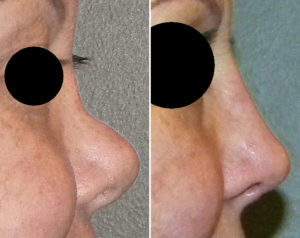The nose is one of the most frequently injured parts of the face due to its prominent location. While low-energy trauma (e.g., fisticuffs) accounts for the largest percent of nasal injuries which are commonly non-displaced or displaced bone fractures, higher energy impacts cause more complex and significant nasal derangements.
Vehicular accidents are one such example of an increasing number of complex nasal injuries. This is particularly evident in three- and four wheeled recreational vehicles where the face is at an opportune level to be hit by passing objects. With such frontal forces, the nose often sustains an impaction injury pushing in both bone and cartilage. This creates a saddle-nose fracture deformity where the support mechanisms of the vertical septum and roof angled cartilage and bone become comminuted and impacted inward toward the nasal cavity.
Reconstruction of the traumatic nose deformity is complicated by the lack of vertical stability of the septum. While primary repair aims for elevation and stabilization of fractured cartilage and bone, collapse of the nasal dorsum and a saddle nose often develops. Secondary reconstruction is commonly needed.

Through an open rhinoplasty approach, the septum is reconstructed and aligned vertically in the midline. Using a resorbable PDS septal plate is really helpful for this step. A long rib cartilage graft which has been sized and carved to extend from the bridge of the nose down to the tip is then placed in the midline. It is usually necessary to place a columellar strut which attaches to this graft to create a classic L-shaped dorso-columellar construct. This serves as the main reconstructive support beam. Onto this the upper lateral cartilages can be attached.
High-energy impacts create a telescoping nasal injury, often leading to a saddlenose deformity. Secondary reconstruction (and can be used in primary repair as well) requires rib cartilage grafting to create a roofline support construct. This approach is far superior to smaller pieces of septal or ear cartilage and is associated with fewer long-term complications than a synthetic implant.
Dr. Barry Eppley
Indianapolis, Indiana


